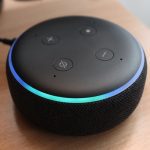Priced at a little lower than $50, these speakers can raise your productivity with their wide range of built-in features and add-ons. Plus, don’t forget their hassle-free participation (read, streaming online songs) in a party. So, it’s only natural that we pit both the smart speakers against each other and see which one wins the crown for the best budget speaker.
Design: Rounded Edge vs Sharp Edge
Apart from that, it has a distinctive LED status ring, which lights up in shades of blue when you trigger it. Besides, it sports an array of seven-microphones on the edges. Though it’s available in two colors — Black and White, you can accessorize this plain look with fabric covers. The fabric covers are available in six different shades. On the other hand, the Google Home Mini doesn’t have any physical buttons except for the mute button at the bottom edge. All the other controls like adjusting volume or triggering the smart speaker can be accessed through voice control. Moreover, the added touch input gives an extra edge to this AI-powered speaker. Unlike the Echo Dot, the top of the Google Home Mini is covered with textured fabric and is available in three colors — Chalk, Charcoal, and Coral. However, in the longer run, the fabric cover may get dirty. Hopefully, Google comes up with some nifty solutions to cover them up. Currently, Google only retails the bases for the mid-sized Google Home. Overall, their small size lets you place them anywhere in the room. Plus, their modern design blends easily with your home decor, especially the Google Home Mini.
Ease of Use: Buttons vs Touch
The presence of physical buttons gives the Echo Dot a clear advantage, as the touch-input of the Mini doesn’t seem to respond all the time. Just tap the button and Alexa will be all ears.
Features: Third-party Skills vs Built-in Features
However, if you want to go a notch higher like asking for food recipes, playing games or tracking your phone, you’d have to enable a couple of third-party skills, courtesy the Smart Home Skill API. The fact that Alexa has been on the market for quite some time gives it the advantage of enhanced third-party skills integration. When it comes to the Google Home device, you’ll find most of the basic skills built-in, thanks to its integration with some of the Google services. Checking quick facts, traffic updates, and spellings, can be done without lifting a finger. When it comes to productivity, the Google Home Mini has plenty of tricks. For instance, you can get the timings of nearby shops or banks. Moreover, it can double up as a remote when you’re watching your favorite Netflix shows.
Sound Quality: The Question of Bass
On the contrary, the Mini can still sound mellow even when the volume is maximum. Also, the Mini comes with an Equalizer in the Google Home app, which you can adjust as per your wish. The Echo Dot doesn’t have explicit equalizer settings but the same can be adjusted through voice control. You just have to say, “Alexa, turn up the bass”. But when it came to catching your inputs, the Echo Dot aces the test with its listening ability. It can catch its trigger name anytime and anywhere, irrespective of the background noise. On a more personal note, I have a slightly thin voice, however, I never found it as an issue while communicating with Alexa. On the contrary, the Google Home Mini can hear you loud and clear only when there is no background noise. If you ask me, sometimes it’s a real struggle to trigger it, especially if you are standing a a few feet away from the device — a problem which doesn’t exist for the Echo Dot.
Streaming Songs: Cast, Stream or Bluetooth
Both the speakers also double up as Bluetooth speakers. All you need to do is pair them with a compatible device through their respective apps. Once done, you can play your offline song collection or even an unsupported app using the smart speakers. A clear advantage of the Google Home Mini is its ability to cast contents. Though it supports the conventional method of casting, it also sports the nifty Guest mode. This mode lets users cast their content directly to the Mini without connecting to Wi-Fi. It comes in handy when you don’t want to share your primary Wi-Fi password.
The Omnipresent Effect: Grouping Multiple Speakers
Thankfully, multiple Echo Dots can be grouped together and the same can be said about the Google Home Minis. You can place them strategically around the house so that you can give your commands without having to move a finger. This grouping makes these speakers double up as a broadcaster or an intercom system. This feature in Alexa goes by the name of Drop in, while Google simply names it as Broadcast. Drop in is available only in the United States and Canada at the time of writing. However, Google’s Broadcast feature works as far as you have Google Assistant enabled on your smartphone.
Wi-Fi Connectivity & Price
The Echo Dot and the Home Mini supports both the 2.4 and 5 GHz WI-Fi networks, As we mentioned earlier, both the prices are in the $49 price bracket, although the Echo Dot is expensive by 0.99 cents.
Which One Should You Buy?
At the end of the day, it ultimately depends on what you are looking for in your AI-powered smart speaker. If you are looking to control a horde of smart home devices, Alexa would be the ideal choice thanks to its support for a wide range of products – both expensive and cheap. Buy However, if you are looking for a device that helps you in getting information easily and keeps your morning brief ready as you’d like it, the Google Home Mini is the right device for you. Plus, the option of seamlessly integrating multiple Google services adds to the list of pros. At the end of the day, it also depends on how many features have been enabled in your region as well. So, before you invest, do check the region-wise limitations. So, which one of these will you buy? Do let us know in the comments section below. Buy The above article may contain affiliate links which help support Guiding Tech. However, it does not affect our editorial integrity. The content remains unbiased and authentic.


























